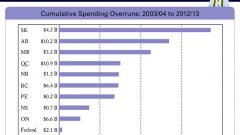What can governments do that individual people and families can’t? They can consistently spend more than they budget for.
In Canada, the federal and various provincial governments have spent more than budgeted for during the last decade. In fact it amounts to the tune of $47 billion dollars.
The C.D. Howe Institute is a public policy think tank based in Toronto Ontario. In a report released today “Credibility on the (Bottom) Line: The Fiscal Accountability of Canada’s Senior Governments, 2013,” they show substantial overshoots of spending estimates, and also of projected revenues during the past decade. The annual report is also known as the “Pinnochio” index, in other words, governments fibbing about expenses and revenues.
The report ranks the federal and provincial governments according to their spring budgets, compared to actual spending and revenue, as well
transparency as in how difficult it is to compare budget intentions with spending in recorded public accounts and other records.
Colin Busby is a senior policy analyst with the CD Howe and co-author of the report. He says, “From basic perspective of transparency and accountability, the idea of going back to compare with previous budgets how well the government has delivered, should be a simple exercise. It’s not”. He added, “”In many provinces and territories, the average citizen or legislator would have trouble simply finding and comparing the key numbers in the budget and in the end-of-year financial reports.”
In terms of transparency, the federal government and the province of Ontario prepare their principal financial documents using the same basis of accounting, display the relevant numbers prominently, and provide informative reconciliations between budgets and results, the report said, giving those two governments, an “A”. In most of the other provinces and territories, inconsistent presentations of multiple revenue and spending figures would stump any but the most expert reader.
In that area: Saskatchewan got a D+, as did Quebec and Newfoundland and Labrador. Alberta got a C.
As for spending, Canada’s resource rich western provinces of Alberta and Saskatchewan had the biggest overshoots and 4 and 5 % over the decade, while the gap for the territories of Yukon and Nunavut were even greater.
Budgets are critical for holding governments accountable to legislators, and in turn to voters and taxpayers. The other co-author of the report, William Robson says, “More accuracy in hitting budgeted amounts would have made today’s taxes and public debt lower” .
However, the report notes that in past five yars there was an improvement by most governments compared to the previous five years. The survey concludes with “ several suggestions about how Canada’s senior governments can improve their financial reporting, and with it the ability of legislators and voters to hold them to account for hitting their budget targets.”








For reasons beyond our control, and for an undetermined period of time, our comment section is now closed. However, our social networks remain open to your contributions.